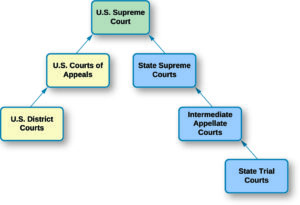How to Submit Evidence in Family Court
Going through a divorce or resolving a family law matter often involves submitting evidence to the court. Evidence helps the judge understand the facts and make an informed decision about your case. Knowing how to properly submit evidence to family court is crucial. Here is a step-by-step guide on how to submit evidence in family court.
Types of Evidence Accepted
Family courts accept both documentary and physical evidence. Some common examples include:
Financial Records
Financial statements, tax returns, bank records, credit card statements, and invoices showing assets, debts, income, and expenses.
Communication Records
Emails, text messages, social media posts, letters, and voicemails demonstrating communications between parties.
Photographs and Videos
Photos and videos documenting injuries, property damage, living conditions of children, etc.
Medical Records
Records related to physical/mental health issues and treatment.
Police Reports
Reports filed for domestic violence, child abuse, etc.
Witness Affidavits
Written statements from witnesses swearing facts under oath.
Expert Reports
Evaluations and opinions from court-appointed or joint experts.
Rules for Submitting Evidence
Follow these rules when submitting evidence to family court:
Relevant
Evidence must be relevant to the issues being decided in your case. Focus on submitting pertinent facts.
Authentic
Originals or certified copies of records must be submitted. Don’t alter or fabricate evidence.
Comprehensible
Judges must be able to understand the evidence. Explain and summarize complex evidence.
Organized
Evidence should be logically organized, tabbed, indexed, and summarized.
Compliant with Rules
Follow all applicable state and local court rules for submitting evidence.
Timely Manner
Evidence must be submitted by any deadlines set by the judge.
How to Get Evidence Admitted
To have your evidence officially considered by the judge, you must get it “admitted” into the record. Follow these tips:
List Evidence in Disclosures
Disclose all your proposed evidence to the other party through mandatory disclosures.
Bring Originals to Court
Have original documents ready for the judge and authenticated copies for the other party.
Lay the Foundation
Before submitting evidence, lay the foundation by explaining what it is, where it came from, and why it’s relevant.
Offer into Evidence
Formally offer each piece of evidence for admission by saying “Your honor, I offer Exhibit 1 into evidence.”
Allow Inspection
The other party can inspect the evidence and make objections before the judge rules on admission.
Respond to Objections
If the other party objects, explain why the evidence should still be admitted.
Get Ruling
The judge will either sustain the objection (exclude evidence) or overrule it (admit evidence).
How to Mark Your Evidence
Properly marking documents and exhibits makes them easier to identify and refer to in court. Follow these guidelines:
Plaintiff’s Exhibits
Number exhibits in sequence – Plaintiff’s Exhibit 1, Plaintiff’s Exhibit 2, etc.
Defendant’s Exhibits
Letter exhibits in sequence – Defendant’s Exhibit A, Defendant’s Exhibit B, etc.
Color Coding
Plaintiff uses yellow exhibit tabs, defendant uses blue.
Descriptive Stickers
Use exhibit stickers with a brief description (e.g. “Photo of son’s bedroom”).
Page Numbers
Add page numbers to multipage exhibits (e.g. 1 of 5, 2 of 5).
Redaction
Hide sensitive info like SSNs, addresses, and financial account numbers.
Exhibit List
Keep a numbered list identifying each exhibit offered.
When to Submit Evidence
Timing is important when submitting evidence. Follow these guidelines on when to provide evidence:
Mandatory Disclosures
Exchange key evidence through initial disclosures at the start of a case.
Supporting Affidavits
File affidavits with temporary orders motions at the beginning.
Response Deadlines
Any evidence that responds to the other party’s motions must meet filing deadlines.
Settlement Offers
Submit evidence of settlement offers with your settlement brochure before mediation.
Pre-trial Submissions
Evidence not previously exchanged must be submitted by the pre-trial deadline.
Day of Trial
Have all original evidence with you in court on the day of trial.
How to Organize and Format Evidence
Submitting evidence in an organized, readable format allows the judge to absorb it more easily. Follow these tips:
Binders with Tabs
Place documents in labeled 3-ring binders with tabbed dividers.
Index of Exhibits
Include a table of contents listing each exhibit.
Summaries
For voluminous records, provide an explanatory summary.
Page Numbers
Add page numbers to multipage exhibits.
Cover Sheet
Attach a exhibit cover sheet with the exhibit number, title, and source.
Clean Copies
Remove staples, torn edges, highlighting, and other markings.
Readable Text
Make sure text is legible and not too small to read.
How to File and Serve Evidence
Properly filing evidence with the court and serving it on opposing parties is critical. Here are some tips:
File with Clerk
File the original evidence with the clerk along with your motion.
Certificate of Service
Include a certificate of service page confirming copies were served.
Serve All Parties
Provide a complete copy to the opposing party/attorney.
Means of Service
Hand delivery, mail, fax, or email are acceptable means of service.
Deadlines
Comply with all deadlines for serving evidence before a hearing.
Keep Copies
Maintain your own copies of all documents filed and served.
Confirm Receipt
Ask the other party to confirm in writing when they received your evidence.
What Evidence Not to Submit
While you want to submit all helpful evidence, some types of evidence are improper or inadmissible. Avoid submitting:
Hearsay
Secondhand statements not heard directly by a witness are usually inadmissible.
Unqualified Opinions
Opinions from non-experts or unsupported by facts may be excluded.
Sensitive Information
Financial account numbers, SSNs, contact information, etc. should be redacted.
Misleading Evidence
Evidence that is altered, incomplete, or inaccurately portrayed can be excluded.
Privileged Information
Confidential communications with doctors, attorneys, clergy, etc. cannot be used without consent.
Superfluous Evidence
Evidence unrelated to the disputed issues wastes the court’s time.
Rule Violations
Evidence obtained illegally or in violation of court rules will likely be inadmissible.
How to Use Evidence at Trial
To make the most of your evidence at trial, keep these pointers in mind:
Refer to Exhibits
When examining witnesses, refer them to specific exhibits to illustrate your points.
Illustrative Aids
Use visuals like charts, graphs, and PowerPoint to highlight key evidence.
Use as Impeachment
If a witness contradicts documentary evidence, use it to point out the inconsistency.
Emphasize Key Points
Draw the judge’s attention to evidence that supports your side during closing arguments.
Anticipate Objections
Be ready to explain why your evidence is relevant and admissible if challenged.
Connect the Dots
Explain how all your evidence fits together to prove your case.
Closing Argument
Summarize the key evidence and explain how it meets the required legal standards.
Other Tips for Submitting Evidence
Lastly, keep these additional tips in mind when submitting evidence in family court:
Be Selective
Only submit your best evidence that proves important facts. Don’t submit everything.
Double Check for Errors
Carefully review that you have the correct documents and exhibits before filing.
Meet Deadlines
Submit evidence in a timely manner according to all applicable rules and deadlines.
Don’t Withhold Evidence
Failing to disclose relevant evidence can seriously damage your credibility.
Be Truthful
Never alter or exaggerate evidence. Candor is critical.
Ask for Help
If unsure about evidence rules, ask an attorney or the court clerk for guidance.
Stay Organized
Keep a master list of all evidence used. Track what is admitted at trial.
Conclusion
Submitting persuasive evidence is one of the most important parts of proving your family law case. Following the proper procedures shows the court you take the process seriously. Taking time to gather quality evidence relevant to the disputed issues also demonstrates your commitment to supporting your claims. While the rules around evidence can be complex in places, focus on being organized, truthful, and thorough in presenting your side of the story through facts. Handled carefully and strategically, the evidence you submit can make all the difference in achieving the outcome you want.
FAQs
How long before trial should evidence be submitted?
Evidence must generally be submitted according to the deadline in the pretrial order, which is often 30 days before trial. Some courts have different timelines, so check local rules.
Can evidence be submitted after the trial starts?
Submitting new evidence after trial starts is difficult. The judge may exclude late evidence unless you prove you couldn’t have obtained it sooner with reasonable diligence.
Should evidence be submitted all together or separately?
Minor evidence is often submitted all together with motions and pretrial disclosures. But key exhibits are better submitted separately to highlight importance. Check local rules.
What is the best way to submit large amounts of evidence?
Break extensive evidence like long financial histories into summarizes with only key documents attached. Use summaries, tables of contents, multiple binders, and other organizational aids.
How many copies of evidence are needed?
Bring originals and copies for the other party and court. Some courts require 2-3 copies of all evidence, so check rules. Also provide copies electronically if permitted.







